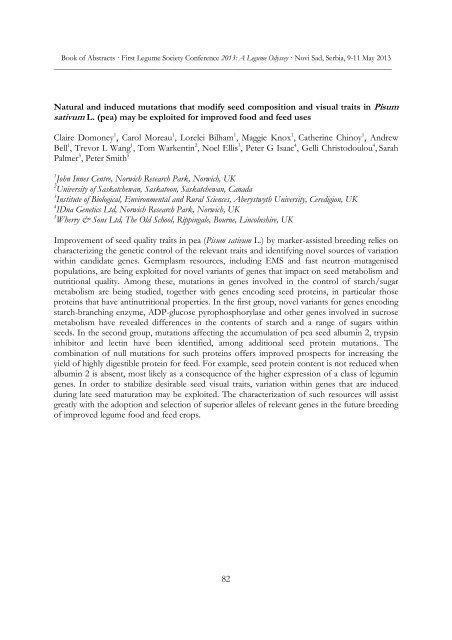Create successful ePaper yourself
Turn your PDF publications into a flip-book with our unique Google optimized e-Paper software.
Book of Abstracts <strong>First</strong> <strong>Legume</strong> <strong>Society</strong> <strong>Conference</strong> 2013: A <strong>Legume</strong> Odyssey Novi Sad, Serbia, 9-11 May 2013<br />
_________________________________________________________________________________________<br />
Natural and induced mutations that modify seed composition and visual traits in Pisum<br />
sativum L. (pea) may be exploited for improved food and feed uses<br />
Claire Domoney 1 , Carol Moreau 1 , Lorelei Bilham 1 , Maggie Knox 1 , Catherine Chinoy 1 , Andrew<br />
Bell 1 , Trevor L Wang 1 , Tom Warkentin 2 , Noel Ellis 3 , Peter G Isaac 4 , Gelli Christodoulou 4 , Sarah<br />
Palmer 5 , Peter Smith 5<br />
1 John Innes Centre, Norwich Research Park, Norwich, UK<br />
2 University of Saskatchewan, Saskatoon, Saskatchewan, Canada<br />
3 Institute of Biological, Environmental and Rural Sciences, Aberystwyth University, Ceredigion, UK<br />
4 IDna Genetics Ltd, Norwich Research Park, Norwich, UK<br />
5 Wherry & Sons Ltd, The Old School, Rippingale, Bourne, Lincolnshire, UK<br />
Improvement of seed quality traits in pea (Pisum sativum L.) by marker-assisted breeding relies on<br />
characterizing the genetic control of the relevant traits and identifying novel sources of variation<br />
within candidate genes. Germplasm resources, including EMS and fast neutron mutagenised<br />
populations, are being exploited for novel variants of genes that impact on seed metabolism and<br />
nutritional quality. Among these, mutations in genes involved in the control of starch/sugar<br />
metabolism are being studied, together with genes encoding seed proteins, in particular those<br />
proteins that have antinutritional properties. In the first group, novel variants for genes encoding<br />
starch-branching enzyme, ADP-glucose pyrophosphorylase and other genes involved in sucrose<br />
metabolism have revealed differences in the contents of starch and a range of sugars within<br />
seeds. In the second group, mutations affecting the accumulation of pea seed albumin 2, trypsin<br />
inhibitor and lectin have been identified, among additional seed protein mutations. The<br />
combination of null mutations for such proteins offers improved prospects for increasing the<br />
yield of highly digestible protein for feed. For example, seed protein content is not reduced when<br />
albumin 2 is absent, most likely as a consequence of the higher expression of a class of legumin<br />
genes. In order to stabilize desirable seed visual traits, variation within genes that are induced<br />
during late seed maturation may be exploited. The characterization of such resources will assist<br />
greatly with the adoption and selection of superior alleles of relevant genes in the future breeding<br />
of improved legume food and feed crops.<br />
82


